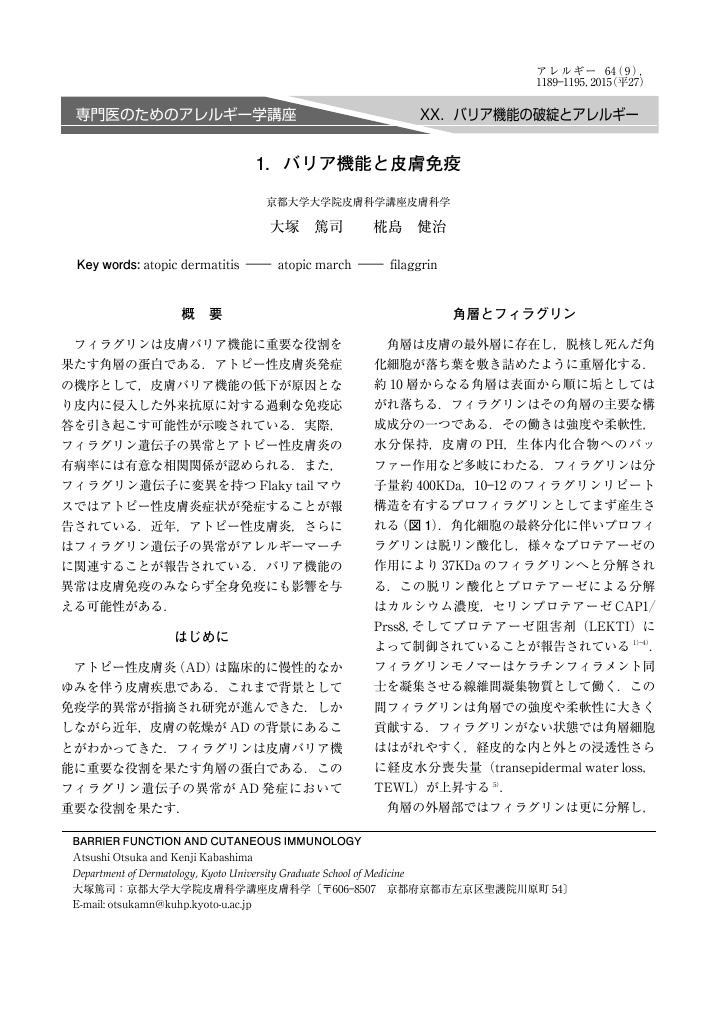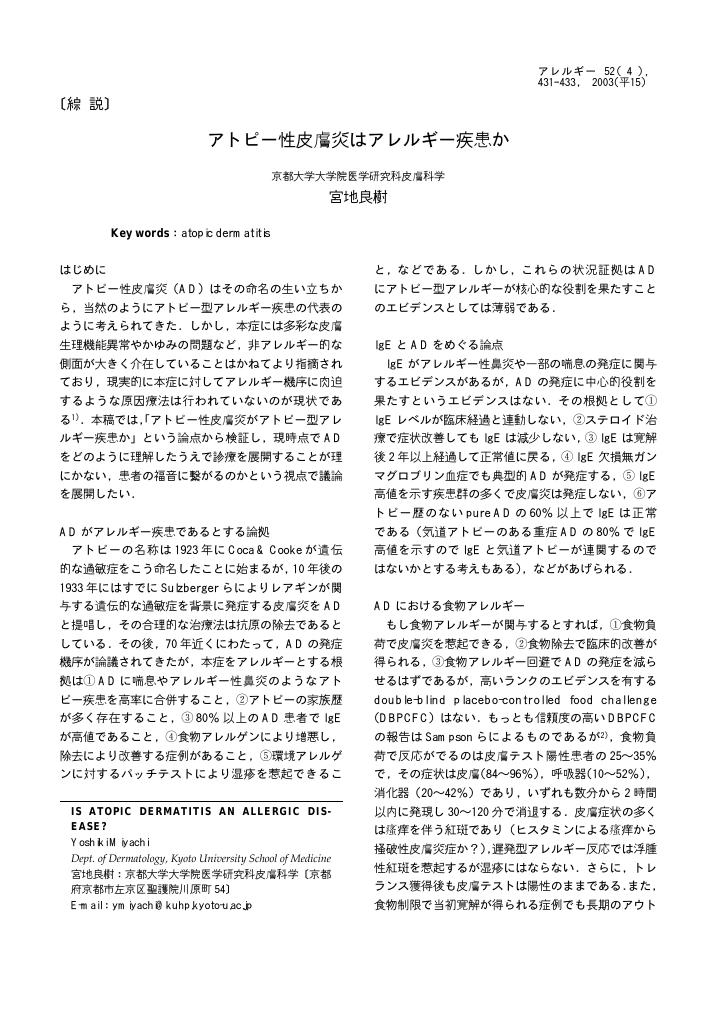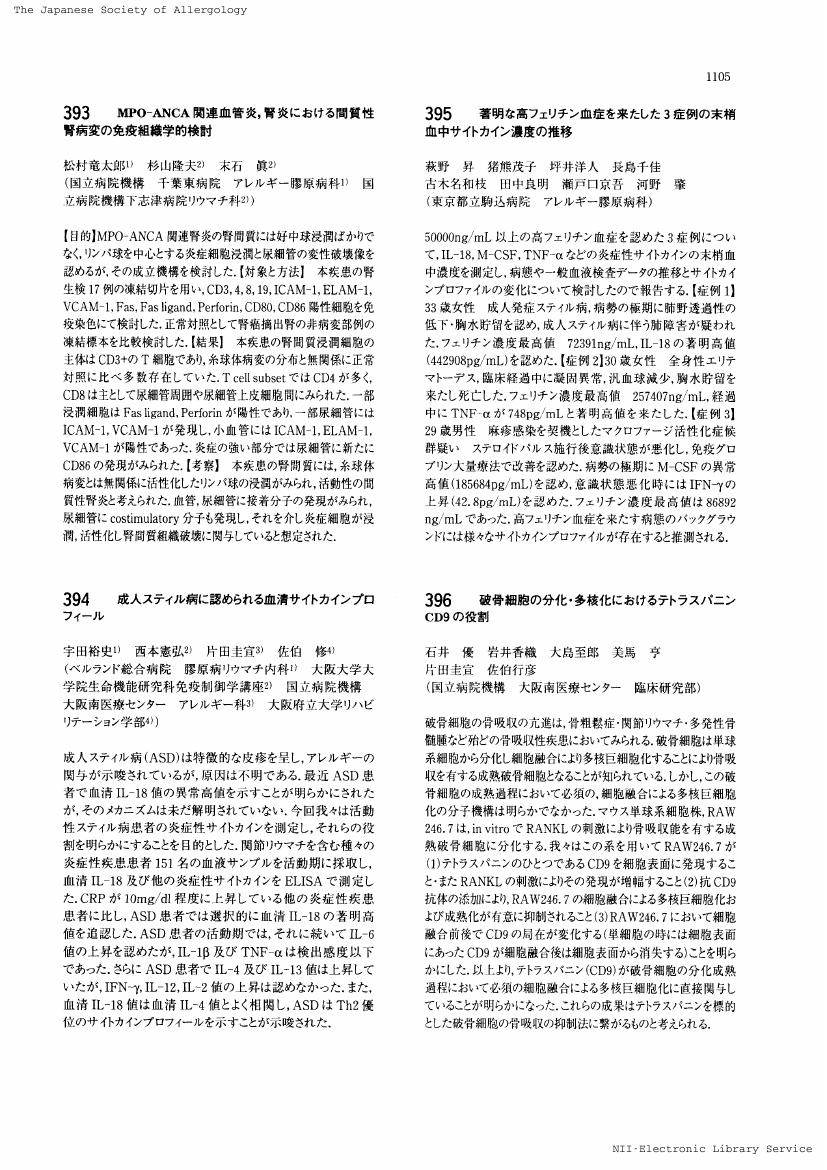3 0 0 0 OA 1.神経生理学から視た痒みの実態 ―TRPチャネルと痒み―
- 著者
- 富永 真琴
- 出版者
- 一般社団法人 日本アレルギー学会
- 雑誌
- アレルギー (ISSN:00214884)
- 巻号頁・発行日
- vol.69, no.1, pp.1-6, 2020 (Released:2020-02-12)
- 参考文献数
- 26
3 0 0 0 口腔アレルギー症候群と各種花粉感作,特にヨモギ花粉感作との関連性
- 著者
- 朝倉 光司 本間 朝 山崎 徳和 石川 忠孝
- 出版者
- 一般社団法人 日本アレルギー学会
- 雑誌
- アレルギー (ISSN:00214884)
- 巻号頁・発行日
- vol.55, no.10, pp.1321-1326, 2006
- 参考文献数
- 16
- 被引用文献数
- 7
【背景,目的】本邦におけるヨモギ花粉症とOASの関連を調べる目的で,ヨモギ花粉症の多い室蘭市において調査を行った.【方法】1998〜2002年に市立室蘭総合病院耳鼻科を受診したアレルギー性鼻炎患者のうち,シラカバ,ヨモギおよびカモガヤのいずれかに対する血清特異的IgE抗体陽性のものを調査対象とし,郵送によるOASに関するアンケート調査を行った.【結果】OAS出現頻度は,シラカバ花粉抗原特異的IgE抗体陽性例あるいはヨモギ花粉抗原特異的IgE抗体陽性例がそれぞれの抗体陰性例よりも有意に高かった(シラカバ; 54.5vs23.5%,p<0.0001,ヨモギ; 41.Ovs21.5%, p<0.01).OAS原因食物は,シラカバ特異抗体のみ陽性の患者ではバラ科の果物が多く,ヨモギ特異抗体のみ陽性の患者では,キウイ,メロン,ミカン,セロリ,タマネギなどバラ科以外の食物がほとんどであった.ヨモギLumiwardスコアの高い患者の中に重症なOAS例が多く含まれる傾向を認めた.【結語】ヨモギ花粉感作とOASの密接な関連性が示唆された.
3 0 0 0 OA 1.バリア機能と皮膚免疫
- 著者
- 大塚 篤司 椛島 健治
- 出版者
- 一般社団法人 日本アレルギー学会
- 雑誌
- アレルギー (ISSN:00214884)
- 巻号頁・発行日
- vol.64, no.9, pp.1189-1195, 2015 (Released:2015-12-08)
- 参考文献数
- 28
3 0 0 0 OA トピックス5.環境因子がアレルギーに及ぼす影響の可能性(小児科領域)
- 著者
- 角田 和彦
- 出版者
- 一般社団法人 日本アレルギー学会
- 雑誌
- アレルギー (ISSN:00214884)
- 巻号頁・発行日
- vol.64, no.1, pp.1-8, 2015 (Released:2015-07-28)
- 参考文献数
- 58
- 被引用文献数
- 1
- 著者
- 久保 允人
- 出版者
- 一般社団法人 日本アレルギー学会
- 雑誌
- アレルギー (ISSN:00214884)
- 巻号頁・発行日
- vol.62, no.11, pp.1443-1450, 2013-11-30 (Released:2017-02-10)
3 0 0 0 OA 花粉症の研究 : I. 空中花粉の季節的変動
- 著者
- 荒木 英齊
- 出版者
- 一般社団法人 日本アレルギー学会
- 雑誌
- アレルギー (ISSN:00214884)
- 巻号頁・発行日
- vol.9, no.8, pp.648-655, 1960-08-01 (Released:2016-10-20)
- 被引用文献数
- 5
Pollinosis is one of the common diseases in the United States and European countries, while it is still in question whether pollinosis really occurs in Japan or not. This discrepancy might be attributed either to the differences in the racial disposition or the atmospheric pollen contents, or the lack of investigation on pollinosis in this country. Hitherto there had been no report on atmospheric pollen counts in Japan. Therefore pollen counts were carried out in Tokyo and its neighbouring town Narashino during 1957 and 1958. Gravity slide method was used, in which each slides were exposed to air for 24 hours from 9.00 a.m. to 9.00 a.m. The result obtained were illustrated in the figures. It was shown that pollen curves in Tokyo and its vicinity consisted of three parts, corresponding to tree, grass, and weed pollens. In other words, there were three pollen seasons in this area like in U.S.A. Pollination period of trees ranged from February or March to June. Japan Cedar and Pine were prevalent. Marked peaks of Pine were found in late April and early May, with a maximum count of 144 in Tokyo. Pollination of grasses began in April and continued till October, whereas their pollen counts were considerably low, especially in June and July (rainy season). Prdominant pollens of the grass curve were of Dactylis glomerata, Alopecurus aequalis, and Miscanthus sinensis. The weed season ranged from August to October. The prevalent pollen was of Short ragweed (Ambrosia Artemisiifolia var.elatio). The peaks were observed in late August and early September, with a maximum count of 95 in Narashino. Giant ragweed was very few and no other ragweed in this area. Comparing with the results of some surveys in U.S.A., the present study seemed to indicate that in Tokyo and its vicinity the pollen concentrations, especially of Short ragweed, were generally lower, but not so extremely lower than those in U.S.A.
3 0 0 0 OA 花粉症の研究 : II花粉による感作について
- 著者
- 荒木 英斉
- 出版者
- 一般社団法人 日本アレルギー学会
- 雑誌
- アレルギー (ISSN:00214884)
- 巻号頁・発行日
- vol.10, no.6, pp.354-370,381, 1961-06-30 (Released:2016-10-20)
- 被引用文献数
- 4
Incidence of sensitization with several air-borne pollens was studied in the Japanese mainly by direct intradermal test, and in some cases Prausnitz-Kustner test, eye test, and provocation by pollen inhalation were studied also. Individuals tested were 265 patients with bronchial asthma, 70 patients with nasal allergy and 602 control persons. Pollens used were short ragweed (Ambrosia artemisiifolia var. elatior), Japanese red pine(Pinus densiflora), Japanese black pine (Pinus Thumbergi), Japanese cedar (Cryptomeria japonica), and Japanese hop (Humulus japonicus). For the comparative study, house dust was also used. In direct skin testing, 0.05 ml of allergen extracts of 1:1000 dilution was injected intracutaneously. In asthmatic patients, each of the distribution curves of diameters of erythema and wheal caused by the intradermal injection with house dust extract showed two peaks with a minimum between them, and the minimum point situated at 15〜20 mm in erythema and 9 mm in wheal. Similar figures were obtained in normal control persons. With short ragweed pollen, it was the same. The first peak, which was estimated to correspond to unspecific reactions, was lower than that of normal control persons, while the second peak which was considered to correspond to specific reactions was higher in asthmatic patients. Only few normal persons and fairly numerous asthmatic patients showed the erythema reactions above 41 mm in diameter. The correlation between erythema and wheal was high (r=0.80 in house dust. r=0.78 in ragweed pollen). From these results. the author proposed the following criteria of intradermal skin test with inhalant allergens; negative (-): erythema less than 10 mm in diameter doubtful (±): erythema 11-20 mm slightly positive (+): erythema 21-40 mm, wheal less than 9 mm moderately positive (〓): erythema 21-40 mm, wheal 10-14 mm strongly positive (〓): erythema above 41 mm, or wheal above 15 mm, or with marked pseudopods After these standards, positive skin reactions to short ragweed pollen were observed in 36% of asthmatic patients, 32% of patients with nasal allergy including bacterial allergy, 52% of patients with nasal allergy except bacterial allergy, and 19% of normal control persons, whereas positive skin reactions to house dust in these four groups were 69%, 51%, 65%, and 23% respectively. But positive skin reactions to Japanese red pine and Japanese cedar pollens were observed far less frequently than that to ragweed pollen, and only very few cases reacted to Japanese black pine and Japanese hop pollens. PK-test was successful in 7 of 11 cases who showed positive intradermal reaction to short ragweed pollen, and in 2 of 3 cases who showed positive intradermal reaction to Japanese red pine pollen. Eye test was carried out with the extracts of pollens, and provocative test by inhalation was done with pollen itself. Both of these test showed positive reactions in rather few cases. Cross reaction between house dust and short ragweed pollen were proved by PK-reaction. House dust might have more allergenic components than short ragweed pollen as judged by skin test. A Japanese patient, who never been abroad but suffering from allergic rhinitis and laryngitis evidently caused by short ragweed pollen, was described in details. Some possible explanations concerning the discrepancy between the results of skin test and the incidence of pollinosis were discussed.
3 0 0 0 OA アトピー性皮膚炎はアレルギー疾患か
- 著者
- 宮地 良樹
- 出版者
- 一般社団法人 日本アレルギー学会
- 雑誌
- アレルギー (ISSN:00214884)
- 巻号頁・発行日
- vol.52, no.4, pp.431-433, 2003-04-30 (Released:2017-02-10)
- 参考文献数
- 4
- 被引用文献数
- 1
3 0 0 0 OA 137 ノイロトロピンのT細胞調節を介する抗アレルギー作用 (1)
- 著者
- 吉井 春夫 深田 有里子 山本 一彦 家後 壽 末広 誠之 柳原 行義 奥平 博一
- 出版者
- 一般社団法人 日本アレルギー学会
- 雑誌
- アレルギー (ISSN:00214884)
- 巻号頁・発行日
- vol.42, no.9, pp.1289, 1993-09-30 (Released:2017-02-10)
3 0 0 0 OA アレルギー疾患に対する補完代替医療のエビデンス
- 著者
- 田中 敏郎
- 出版者
- 一般社団法人 日本アレルギー学会
- 雑誌
- アレルギー (ISSN:00214884)
- 巻号頁・発行日
- vol.61, no.11, pp.1649-1656, 2012-11-30 (Released:2017-02-10)
- 参考文献数
- 52
3 0 0 0 OA 皮膚バリア機能からみたアトピー性皮膚炎の治療
- 著者
- 海老原 全
- 出版者
- 一般社団法人 日本アレルギー学会
- 雑誌
- アレルギー (ISSN:00214884)
- 巻号頁・発行日
- vol.63, no.6, pp.758-763, 2014-06-01 (Released:2017-02-10)
- 被引用文献数
- 1
- 著者
- 塩見 一雄
- 出版者
- 一般社団法人 日本アレルギー学会
- 雑誌
- アレルギー (ISSN:00214884)
- 巻号頁・発行日
- vol.57, no.11, pp.1083-1093, 2008-11-30 (Released:2017-02-10)
- 参考文献数
- 43
3 0 0 0 OA アレルギー疾患の心理的側面の評価と治療
- 著者
- 久保 千春 千田 要一
- 出版者
- 一般社団法人 日本アレルギー学会
- 雑誌
- アレルギー (ISSN:00214884)
- 巻号頁・発行日
- vol.54, no.11, pp.1254-1259, 2005-11-30 (Released:2017-02-10)
- 参考文献数
- 21
- 被引用文献数
- 1
3 0 0 0 OA 次世代のためのアレルギー疾患発症の予防戦略
- 著者
- 斎藤 博久
- 出版者
- 一般社団法人 日本アレルギー学会
- 雑誌
- アレルギー (ISSN:00214884)
- 巻号頁・発行日
- vol.65, no.10, pp.1264-1268, 2016 (Released:2016-12-27)
- 参考文献数
- 22
- 著者
- 林 大輔 青木 健 柴田 瑠美子 市川 邦男
- 出版者
- 一般社団法人 日本アレルギー学会
- 雑誌
- アレルギー (ISSN:00214884)
- 巻号頁・発行日
- vol.59, no.12, pp.1628-1633, 2010-12-30 (Released:2017-02-10)
- 参考文献数
- 10
症例は6歳男児.現在までにアサリ以外は貝類を含む食物のアレルギーはない.2歳よりアサリ摂取後に嘔吐を繰り返しているため近医を受診したが,アサリ特異的IgEが陰性であり,精査のため当院に紹介された.アサリ特異的IgEは1.04UA/mlでスキンプリックテストは膨疹径4mmであった.生アサリによるパッチテストは陽性,リンパ球刺激試験も陽性(5305cpm,SI=1211%)であった.ゆでたアサリによる経口負荷試験では摂取2時間後に腹痛と嘔吐が出現,末梢血好中球数も負荷前の2924/μlから負荷6時間後に16082/μlまで増加した.これらの検査所見よりアサリによるFood protein enterocolitis syndrome(FPEIS)と診断した.現在まで貝類によるFPIESの報告はなく,本報告が初となる.
- 著者
- 小宮山 謙一郎 増本 愛 西原 冬実 小林 威仁 杣 知行 萩原 弘一 金澤 實 永田 真
- 出版者
- 一般社団法人 日本アレルギー学会
- 雑誌
- アレルギー (ISSN:00214884)
- 巻号頁・発行日
- vol.62, no.12, pp.1631-1641, 2013-12-30 (Released:2017-02-10)
【背景・目的】迅速IgE測定システムとして開発されたImmunoCAP^[○!R] Rapidを用いてアレルギー疾患患者の特異的IgE抗体を測定し,プリックテスト(SPT)と比較することでその有用性を検討した.【方法】2010年9月から2012年2月までにアレルギー疾患が疑われた患者83名を対象とした.患者背景は年齢中央値43歳で,喘息53例,アレルギー性鼻炎が42例であった.【結果】全アレルゲンの陽性率はImmunoCAP^[○!R] Rapidに比べSPTが高い陽性率(22.5% vs 26.5%, p<0.05)となったが,スギ抗原ではImmunoCAP^[○!R] Rapidが陽性率は同等であり(68.7% vs 55.4%, p=0.07), 鼻炎患者においては有意に高い陽性率(90.4% vs 71.4%, p<0.05)を示した. SPT陽性をベースにしたImmunoCAP^[○!R] Rapidの感度66.9%, 特異度93.4%, 陽性・陰性一致率86.4%であった.アレルゲン別に検討すると,スギとダニの各々の感度は93.5%, 73.8%, 特異度は62.2%, 92.7%と高値を示し,診断効率は86.4%, 83.1%と良好であった.また,IgEの判定結果と皮膚反応(紅斑,膨疹)の相関性もみられた(r=0.645, 0.657).【結語】SPTに比べImmunoCAP^[○!R] Rapidのアレルゲン同定率はやや劣るが,主要アレルゲンであるスギやダニ患者のアレルゲン同定には有用と考えられた.
3 0 0 0 OA 5 治療と対策(患者の治療)(シンポジウム1 化学物質過敏症)
- 著者
- 坂部 貢
- 出版者
- 一般社団法人 日本アレルギー学会
- 雑誌
- アレルギー (ISSN:00214884)
- 巻号頁・発行日
- vol.51, no.9-10, pp.807, 2002-10-30 (Released:2017-02-10)
- 著者
- 尾辻 健太 大原 佳央里 中村 真紀 雨積 涼子 比嘉 千明 嘉数 健二 近藤 康人
- 出版者
- 一般社団法人 日本アレルギー学会
- 雑誌
- アレルギー (ISSN:00214884)
- 巻号頁・発行日
- vol.64, no.1, pp.63-67, 2015 (Released:2015-07-28)
- 参考文献数
- 7
食物アレルギー歴のない17歳女性が,すき焼きを摂取後にアナフィラキシーを起こした症例を経験した.皮膚試験で陽性であったエノキタケを入院の上オープン法で経口負荷試験しエノキタケが原因食品であることが確かめられた.これまでエノキタケによるアナフィラキシーの報告はなく,アレルゲンについても報告されていない.今回患者血清を利用しアレルゲンの同定を試みた.市販のエノキタケから抗原を抽出し,患者血清を用いてWestern-blottingを行ったところ,複数のタンパク質バンド(18kDa,39kDa,50kDa)に特異的な反応がみられ,これらがアレルゲンであると考えた.
3 0 0 0 OA 4.肥満とアトピー性皮膚炎, アレルギー性鼻炎
- 著者
- 楠 隆
- 出版者
- 一般社団法人 日本アレルギー学会
- 雑誌
- アレルギー (ISSN:00214884)
- 巻号頁・発行日
- vol.66, no.8, pp.984-989, 2017 (Released:2017-09-14)
- 参考文献数
- 25













